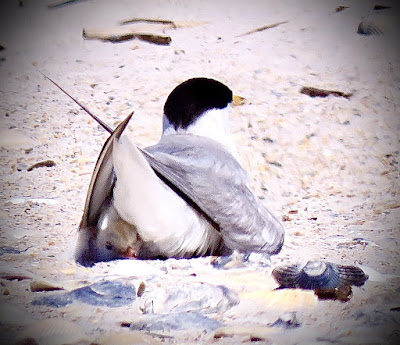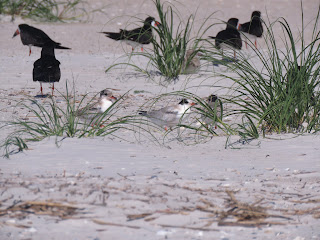Least Terns (LETE) are spending the day feeding and protecting their many chicks from the heat and potential predators.
Look for chicks in and around the “chick shelters” and the many plants. The shelters are helpful against both heat and potential predators. We are seeing more LETE chicks than last week and we are beginning to count fledglings. Fledglings are chicks that have grown their flight feathers and are the size of the adult birds. We think you will enjoy the opportunity to witness these first flights. The chicks practice jumping into the wind and take short flights with the parent bird close by. After the initial flight lessons, we will begin seeing the chicks learn to hover over the water to watch fish and judge how fast the fish are moving and then begin fishing skill lessons.
 |
| Photo by Camille Daniels |
Common Tern (COTE) chicks and fledglings can be seen throughout the posting and on the beach and the COTE parents have been actively keeping beachgoers (and bird stewards!) a safe distance away. We initially counted 15 Common Tern nests throughout the posting but now believe there may be more in the plants. Thirteen fledglings were counted this week on the inlet side and we know there are another 2 fledglings oceanside.
 |
| Photo by Camille Daniels |
We have close to 400 Black Skimmers in the nesting area with more than 166 pairs nesting. We have a number of non-breeding Black Skimmers in the colony this year gaining experience for nesting in the future!
Black Skimmer Chicks can be seen throughout the posting and are getting to be a good size by begging for food constantly and growing their flight feathers. If you see a Black which is Skimmer flying in with a fish, follow it with your binoculars right to its nest to feed chicks which is both adorable and energy intensive for these parent birds. Nesting and incubation continues along the back dune.
 |
| Photo by Camille Daniels |
 |
| Photo by Camille Daniels |
The Oystercatcher chicks which made their appearance on May 24 are growing nicely thanks to the intensive efforts of the single parent (EMY) and the unbanded helper bird. The chicks have reached a good size although, as expected, one chick is larger than the other. We were able to band the largest chick on Saturday, June 25...ETX! The chicks are so adorable when they run out of the dunes to greet the parent bird with food from the marsh. It seems that most often the biggest chick gets to the food first, but the little guy will also tug on the oyster meat and break off his/her share!
You will see the Oystercatcher chicks unsupervised on the beach during feeding and they are becoming rather “street/beach smart”. The chicks are very aware of people and run into the posting as vehicles or people approach.















No comments:
Post a Comment